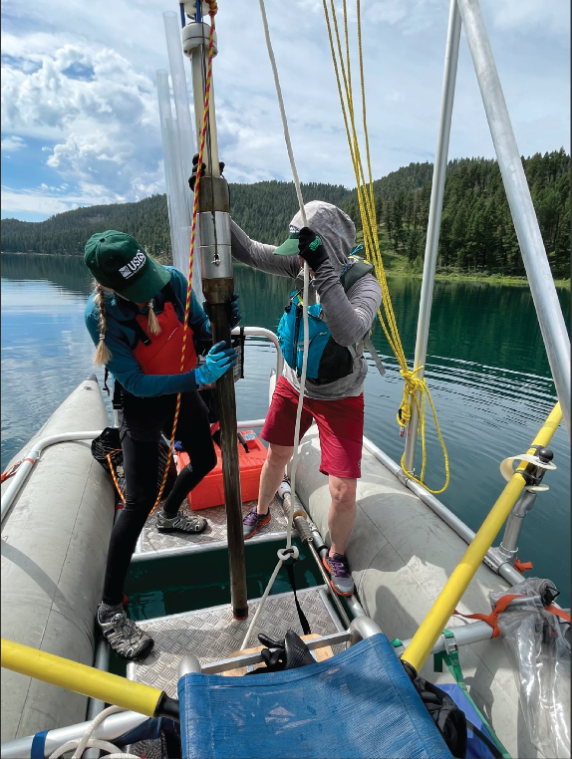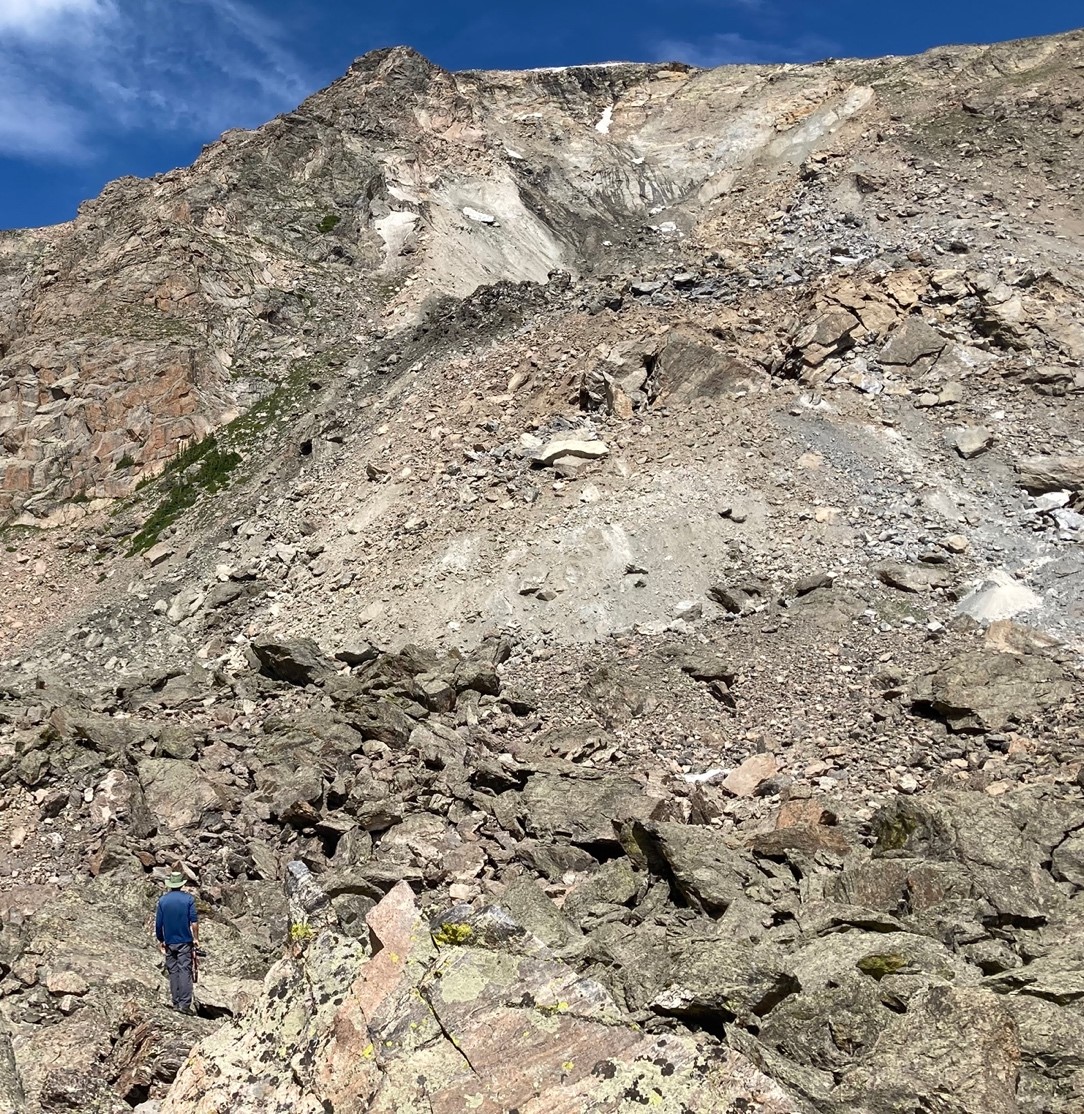Talks at Colorado Scientific Society Meetings in 2024
CSS January 2024 Meeting
The US Geological Survey National Seismic Hazard Model
Thursday, January 18, 2024 at 7:00 p.m.
Allison M. Shumway, U.S. Geological Survey
This meeting was held at Calvary Church Golden.

Abstract: The U.S. National Seismic Hazard Model (NSHM) was updated in 2023 for all 50 states using new science on seismicity, fault ruptures, ground motions, and probabilistic techniques to produce a standard of practice for public policy and other engineering applications (defined for return periods greater than ~475 or less than ~10,000 years). Changes in 2023 time independent seismic hazard (both increases and decreases compared to previous NSHMs) are substantial because the new model considers more data and updated earthquake rupture forecasts and ground motion components. In developing the 2023 model, we tried to apply best available or applicable science based on advice of co-authors, more than 50 reviewers, and hundreds of hazard scientists and end users, who attended public workshops and provided technical inputs. The hazard assessment incorporates new catalogs, declustering algorithms, gridded seismicity models, magnitude-scaling equations, fault-based structural and deformation models, multi-fault earthquake rupture forecast models, semi-empirical and simulation-based ground motion models, and site amplification models conditioned on shear wave velocities of the upper 30 m of soil and deeper sedimentary basin structures. Seismic hazard calculations yield hazard curves at hundreds of thousands of sites, ground motion maps, uniform hazard response spectra, and disaggregations developed for pseudo-spectral accelerations at 21 oscillator periods and two peak parameters, Modified Mercalli Intensity, and 8 site classes required by building codes and other public policy applications. Tests show the new model is consistent with past ShakeMap intensity observations. Sensitivity and uncertainty assessments ensure resulting ground motions are compatible with known hazard information and highlight the range and causes of variability in ground motions. We produce several impact products including building seismic design criteria, intensity maps, planning scenarios, and engineering risk assessments showing the potential physical and social impacts. These applications provide a basis for assessing, planning, and mitigating the effects of future earthquakes.
Website: For more information about the USGS National Seismic Hazard Models, please visit their website: https://www.usgs.gov/programs/earthquake-hazards/hazards.
Bio: Allison Shumway is a research geophysicist at the U.S. Geological Survey (USGS) in Golden, CO where for the last nine years she has worked on seismicity catalog development, seismic source model characterization and implementation, and probabilistic seismic hazard analysis (PSHA) as part of the National Seismic Hazard Model Project. Prior to working at the USGS, she spent seven years working at a geophysical consulting company where she worked on a number of PSHA projects, including for nuclear power plant sites in the U.S. She received her M.S. in Earth Sciences from the University of Memphis in Memphis, TN (at the Center for Earthquake Research and Information) and her B.A. in Geological Sciences at the State University of New York at Geneseo in Geneseo, NY.
=
CSS February Meeting
Lacustrine Paleoseismology in the Intermountain West
Thursday, February 15, 2024
Sylvia R. Nicovich,
Mendenhall Fellow|Research Geologist
Geologic Hazards Science Center
U.S. Geological Survey
This meeting was held at Calvary Church Golden.
Abstract: Seismic hazard analysis hinges on the ability to characterize seismic sources, especially active faults. Our understanding of fault activity within the Intermountain West (IMW) relies on paleoseismic trench studies, which are limited to surface-rupturing earthquakes preserved within terrestrial strata that typically represent short-timescales and thus a limited earthquake record. Recently, paleoseismologists have begun exploring lake sediments for evidence of paleoearthquakes, as lacustrine systems commonly offer long-timescale and largely continuous sedimentation records that have potential to expand earthquake-history observations and refine event timing. Worldwide, many of these studies focus on active faults within the Alpine and Anatolian orogenic belts, where lake records reveal the Holocene history of large ground-shaking events. Within the United States, lacustrine paleoseismology has been centered on the Pacific coast and Alaska, studying the recurrence of subduction-related earthquakes versus crustal faulting. Here, we apply this sub-discipline of earthquake geology to the Intermountain West with an objective to calibrate how lakes record earthquakes in the intraplate environment of North America. We leverage both historical and recognized terrestrial (trench) paleosemic events to corroborate the evidence of ground shaking withing lake systems. Currently, we are documenting the signature of the 1959 M7.3 Hebgen Lake earthquake in multiple lakes around the West Yellowstone region as well as comparing terrestrial earthquake records for the Wasatch Front, Utah, with shaking proxies recorded in the Great Salt Lake. The application of lacustrine paleoseismology to the Intermountain West will not only help to refine event timing uncertainties, but will offer longer records of ground shaking, which present the opportunity to provide more robust parameters for seismic hazard analysis and a greater understanding of intraplate neotectonic behavior.

Sylvia Nicovich is a Mendenhall Research Fellow at the U.S. Geological Survey Geologic Hazards Science Center in Golden, CO studying lacustrine paleoseismology in the Intermountain West. Prior to her Mendenhall assignment, she conducted paleoseismologic investigations for seismic hazard analysis at the Bureau of Reclamation in Lakewood, CO. Sylvia earned a PhD in Geology from Montana State University in 2020 with a dissertation that focused on alluvial fan geomorphic and sedimentary records. She also holds BS and MS degrees from Cal Poly Humboldt, where she studied active faults in the northern California fold and thrust belt.
View Zoom Recording of Lacustrine Paleoseismology in the Intermountain West
Watching this video is best in full screen. (It may sharpen up images.)
No passcode is needed to access this recording. Just click on the video.
Duration: 00:58:41
DISCLAIMER and FAIR-USE STATEMENT: The following Zoom-meeting recording contains content that expresses the opinions, viewpoints, and conclusions of the speakers and does not necessarily reflect the views, policies, or endorsements of the Colorado Scientific Society. This recording is made available to the public for general information and educational purposes only and is not intended to be used for profit. Any use of copyrighted material included therein for other purposes must obtain express written permission from the author.
=
CSS March Meeting
The 2022 Chaos Canyon landslide: an ice-rich debris slide in Rocky Mountain National Park
<Thursday, March 21, 2024
Kate Allstadt, U.S. Geological Survey
This meeting was held at Calvary Church Golden.

Photo credit USGS/K.Allstadt
Abstract: On 28 June 2022, ~2 million cubic meters of ice-rich debris mobilized from the southeast flank of Hallett Peak in Rocky Mountain National Park. The material slid rapidly for about 245 m into Chaos Canyon, a popular bouldering destination in the park. The slide stopped when it reached a deposit composed of massive boulders filling the valley floor that has been previously mapped as a relict rock glacier. Several climbers were bouldering near the toe of the landslide when it occurred. The group narrowly escaped and caught parts of the event on video, resulting in substantial nationwide media coverage. In this talk, I will detail a multifaceted investigation in which we used eyewitness accounts, field and remote sensing techniques, historic climate data, and seismic recordings to unravel the mysteries of this unusual landslide sequence and the events leading up to it. Direct observations of melting blocks of icy debris in the landslide deposits, coupled with decades of slope deformation patterns correlated with warming temperatures, strongly suggest permafrost degradation was a major contributing factor.
The full study is publicly available here:
The 2022 Chaos Canyon landslide in Colorado: Insights revealed by seismic analysis, field investigations, and remote sensing
Short video of the Chaos Canyon rock slide on CBS Channel 7:
https://www.cbsnews.com/colorado/news/usgs-terrain-moving-two-decades-before-rmnps-chaos-canyon-rock-slide
In the window that opens, scroll down until you see
VIDEO Rock slide closes Chaos Canyon area in Rocky Mountain National Park (2022)
Click on it. There will be an add and the news clip may come up with the sound muted.
Biography: Kate Allstadt has been a Research Geophysicist at the USGS Geologic Hazards Science Center in Golden, CO since 2015. Kate conducts multidisciplinary approaches, commonly incorporating seismic and geophysical techniques, to study landslide, earthquake, and volcano hazards. She currently focuses on earthquake-triggered ground failure, near-real-time earthquake impacts, seismic monitoring of debris flows and lahars, and studies of massive rapid landslides using seismic methods and numerical modeling. Kate completed her PhD in Seismology at University of Washington in 2013 and her MS in Engineering Seismology jointly at the Université Joseph Fourier, Grenoble, France and ROSE School, Pavia, Italy.
View Zoom Recording of 2022 Chaos Canyon landslide in Rocky Mountain National Park
Watching this video is best in full screen. (It may sharpen up images.)
No passcode is needed to access this recording. Just click on the video.
Duration: 01:19:14
DISCLAIMER and FAIR-USE STATEMENT: The following Zoom-meeting recording contains content that expresses the opinions, viewpoints, and conclusions of the speakers and does not necessarily reflect the views, policies, or endorsements of the Colorado Scientific Society. This recording is made available to the public for general information and educational purposes only and is not intended to be used for profit. Any use of copyrighted material included therein for other purposes must obtain express written permission from the author.


